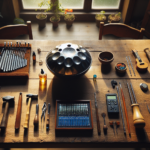Introduction
The handpan is a relatively new and captivating instrument that has taken the world by storm with its unique, ethereal sounds. Originating from the original concept of the Hang, created in Switzerland in 2000, the handpan has become a preferred choice for musicians interested in world music, meditation, and sound therapy. One of the essential skills to enhance your handpan playing is mastering thumb control. In this guide, we will delve into the beginner’s techniques for thumb control, allowing you to create beautiful melodies and rhythms on this enchanting instrument.
Understanding Handpan Anatomy
Before we focus on thumb control, it’s crucial to understand the structure of the handpan. Typically made from steel, the instrument features a central note (referred to as the Ding) surrounded by other notes in a circle. Each note is played by striking different areas with your hands, resulting in the unique resonant tones the handpan is known for. Understanding the layout and the different sounds produced by each note will help you in utilizing thumb control effectively.
Positioning Your Hands
To achieve the best sound using thumb control, begin by setting your handpan on a stable surface or stand that places the instrument at a comfortable height. Sit with a straight back to avoid strain and place your hands lightly on the surface. Each note should be approached with gentle precision, using the pads of your thumbs. By maintaining a relaxed posture, you’ll have better flexibility, allowing your thumbs to move effortlessly across the instrument.
Thumb Technique Basics
The thumb is often the most versatile and agile digit, making it perfect for playing intricate patterns on the handpan. Begin your practice by using the “thumb roll” technique, which involves allowing your thumb to roll from one note to the next smoothly. This technique helps in maintaining fluidity and preventing harsh attacks on the note.
Exercises for Thumb Control
Exercise 1: Single Note Hits
Start by selecting a single note on the handpan. Position your thumb slightly curved and strike the note gently. Aim for a clean, resonant sound. Repeat this multiple times, focusing on evenness and consistency in the volume of each hit.
Exercise 2: Thumb Rolls
Select two adjacent notes. Use your thumb to gently roll from the first note to the second note, back and forth. The goal is to achieve a seamless transition without any gaps or changes in sound quality. Practice this until you can move smoothly between the notes.
Exercise 3: Thumb and Finger Combinations
Integrate your thumb movements with other fingers to create dynamic rhythms. Start with your thumb on one note and another finger on an adjacent note. Practice alternating between the two, gradually increasing speed. This will build dexterity and independence of motion.
Developing Rhythmic Patterns
Rhythm is key to a captivating handpan performance. Begin by choosing a simple time signature, such as 4/4, and practice playing consistent beats using your thumbs. Experiment with different patterns like quarter notes, eighth notes, and syncopated rhythms. Use a metronome to keep time and gradually increase your speed as you become more comfortable.
Exploring Dynamics and Articulation
Dynamics and articulation can add depth and emotion to your handpan performance. Practice varying the pressure and speed of your thumb strikes to produce different dynamic levels, from soft, whispering tones to bold, resonant notes. Also, experiment with articulations, such as staccato (short, detached notes) and legato (smooth, connected notes), to add expression to your playing.
Common Challenges and Solutions
As with any musical skill, mastering thumb control on the handpan comes with its challenges. Beginners might struggle with uneven pressure, creating inconsistent sounds. To tackle this, focus on maintaining a steady hand, using deliberate movements, and practicing slowly. It’s also common to experience fatigue; to prevent this, take regular breaks during practice sessions to rest your fingers and thumbs.
Conclusion
Mastering thumb control on the handpan can elevate your playing, allowing you to create intricate melodies and captivating rhythms. Remember, patience and practice are your best allies in developing this skill. Through consistent exercises, proper posture, and experimentation, you will find your unique voice on the handpan. Embrace the journey of learning and let the enchanting sounds of your handpan inspire you and your listeners.
Frequently Asked Questions
1. How long should I practice thumb control each day?
It’s recommended to start with 15-30 minutes of focused practice each day, gradually increasing the duration as your skills develop. Remember to take breaks to avoid strain.
2. Can I use thumb control on other percussion instruments?
Yes, many of the skills you develop with thumb control on the handpan can be applied to other percussion instruments, such as congas or djembes, enhancing your overall percussive abilities.
3. Do I need any accessories to practice thumb control?
No special accessories are required, but a metronome can be beneficial for keeping time during practice sessions. Ensure your handpan is placed on a stable surface or stand at a comfortable height.
4. How do I know if I’m using the correct thumb technique?
Ensure your thumbs are relaxed and slightly curved, with movements originating from your wrist and forearm rather than your hand. If your notes sound harsh, try adjusting your finger position and strike pressure.
5. Are there any online resources or communities for handpan learners?
Yes, there are numerous online platforms, forums, and social media groups where handpan enthusiasts share tips and tutorials. Joining these communities can provide support and additional resources to aid your learning.





